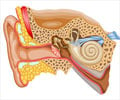Children with acute ear infections have been found to get better without antibiotics although the infection may have been so severe that an emergency room visit had been prompted.
A recent study revealed that although two-thirds of children were given a prescription for antibiotics, to be used just in case of need, they have to get the prescription filled to get better.The study's lead author, Dr. David Spiro, who was at Yale University School of Medicine at the time of the study, said, "Our study evaluated a 'wait-and-see' prescription for ear infections in children. Compared to children who were given antibiotics, children in the wait-and-see group had the same outcomes."
Spiro heads the Pediatric Emergency Medicine at Doernbecher Children's Hospital and Oregon Health and Science University in Portland and said that by giving parents a prescription and asking them to fill the prescription only if the child developed a higher fever or had continued ear pain, doctors can empower families to become part of the child's health-care team.
In addition, offering the wait-and-see prescriptions, doctors can help families save time and money by avoiding taking time off work to meet the doctor again if the child's condition worsens because they would already have a prescription in hand.
The research has been published in the Sept. 13 issue of the Journal of the American Medical Association.
Every year, about 15 million antibiotic prescriptions are filled for the treatment of acute ear infections, also known as acute otitis media.
Advertisement
Although earlier studies have shown that children who don't have severe otitis media often get better without antibiotic treatment, the new study looked at a sicker group of children to see whether they could wait to take antibiotics without developing complications.
Advertisement
The researchers randomly selected one hundred and forty-five children for the standard prescription group, after being given a prescription for antibiotics they were told to fill it. The ‘wait and see’ group consisted of 138 children whose parents were also given a prescription, but were asked to wait to fill it only if the child showed no signs of improvement or had worsened in the 48 hours following their emergency-room visit.
The researchers found that in the standard prescription group, 87 percent of parents filled their child's prescriptions, while only 38 percent of the parents in the wait-and-see group ended up doing so. Besides this there were no statistically significant differences in the rates of fever, ear pain, and additional medical visits between the two groups.
Parents in the wait-and-see group who did end up filling the prescriptions cited mainly reasons of fever and ear pain.
Spiro suggested, "If your child has an uncomplicated ear infection, ask your doctor if they can give you a wait-and-see prescription."
Dr. Irwin Benuck, attending pediatrician at Children's Memorial Hospital in Chicago and professor of clinical pediatrics at Northwestern University, said that parents, especially the younger generation parents, are getting the message that antibiotics aren't always the answer for every illness.
He said, "Pediatricians are trying as hard as they can not to prescribe antibiotics unless they're necessary."
Spiro did advise that children under 6 months of age, children with chronic ear infections, and children who appear seriously ill should be treated with the ‘wait and see’ approach.
Source-Medindia
NLA











